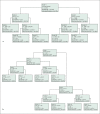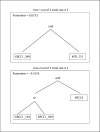DNA repair polymorphisms modify bladder cancer risk: a multi-factor analytic strategy
- PMID: 17898541
- PMCID: PMC2857629
- DOI: 10.1159/000108942
DNA repair polymorphisms modify bladder cancer risk: a multi-factor analytic strategy
Abstract
Objectives: A number of common non-synonymous single nucleotide polymorphisms (SNPs) in DNA repair genes have been reported to modify bladder cancer risk. These include: APE1-Asn148Gln, XRCC1-Arg399Gln and XRCC1-Arg194Trp in the BER pathway, XPD-Gln751Lys in the NER pathway and XRCC3-Thr241Met in the DSB repair pathway.
Methods: To examine the independent and interacting effects of these SNPs in a large study group, we analyzed these genotypes in 1,029 cases and 1,281 controls enrolled in two case-control studies of incident bladder cancer, one conducted in New Hampshire, USA and the other in Turin, Italy.
Results: The odds ratio among current smokers with the variant XRCC3-241 (TT) genotype was 1.7 (95% CI 1.0-2.7) compared to wild-type. We evaluated gene-environment and gene-gene interactions using four analytic approaches: logistic regression, Multifactor Dimensionality Reduction (MDR), hierarchical interaction graphs, classification and regression trees (CART), and logic regression analyses. All five methods supported a gene-gene interaction between XRCC1-399/XRCC3-241 (p = 0.001) (adjusted OR for XRCC1-399 GG, XRCC3-241 TT vs. wild-type 2.0 (95% CI 1.4-3.0)). Three methods predicted an interaction between XRCC1-399/XPD-751 (p = 0.008) (adjusted OR for XRCC1-399 GA or AA, XRCC3-241 AA vs. wild-type 1.4 (95% CI 1.1-2.0)).
Conclusions: These results support the hypothesis that common polymorphisms in DNA repair genes modify bladder cancer risk and highlight the value of using multiple complementary analytic approaches to identify multi-factor interactions.
(c) 2007 S. Karger AG, Basel.
Figures



Similar articles
-
Polymorphisms of the DNA repair genes XRCC1, XRCC3, XPD, interaction with environmental exposures, and bladder cancer risk in a case-control study in northern Italy.Cancer Epidemiol Biomarkers Prev. 2003 Nov;12(11 Pt 1):1234-40. Cancer Epidemiol Biomarkers Prev. 2003. PMID: 14652287
-
Polymorphisms/haplotypes in DNA repair genes and smoking: a bladder cancer case-control study.Cancer Epidemiol Biomarkers Prev. 2005 Nov;14(11 Pt 1):2569-78. doi: 10.1158/1055-9965.EPI-05-0189. Cancer Epidemiol Biomarkers Prev. 2005. PMID: 16284380
-
Concordance of multiple analytical approaches demonstrates a complex relationship between DNA repair gene SNPs, smoking and bladder cancer susceptibility.Carcinogenesis. 2006 May;27(5):1030-7. doi: 10.1093/carcin/bgi284. Epub 2005 Nov 25. Carcinogenesis. 2006. PMID: 16311243
-
Polymorphisms in XPC, XPD, XRCC1, and XRCC3 DNA repair genes and lung cancer risk in a population of northern Spain.BMC Cancer. 2007 Aug 16;7:162. doi: 10.1186/1471-2407-7-162. BMC Cancer. 2007. PMID: 17705814 Free PMC article.
-
Gene-environment interactions between the smoking habit and polymorphisms in the DNA repair genes, APE1 Asp148Glu and XRCC1 Arg399Gln, in Japanese lung cancer risk.Carcinogenesis. 2004 Aug;25(8):1395-401. doi: 10.1093/carcin/bgh153. Epub 2004 Mar 25. Carcinogenesis. 2004. PMID: 15044328
Cited by
-
XPD Lys(751)Gln and Asp (312)Asn polymorphisms and bladder cancer risk: a meta-analysis.Mol Biol Rep. 2010 Jan;37(1):301-9. doi: 10.1007/s11033-009-9693-1. Epub 2009 Aug 8. Mol Biol Rep. 2010. PMID: 19669592
-
The association of APE1 -656T > G and 1349 T > G polymorphisms and cancer risk: a meta-analysis based on 37 case-control studies.BMC Cancer. 2011 Dec 18;11:521. doi: 10.1186/1471-2407-11-521. BMC Cancer. 2011. PMID: 22176746 Free PMC article. Review.
-
Genetic population structure analysis in New Hampshire reveals Eastern European ancestry.PLoS One. 2009 Sep 7;4(9):e6928. doi: 10.1371/journal.pone.0006928. PLoS One. 2009. PMID: 19738909 Free PMC article.
-
DNA repair gene XRCC1 polymorphisms, smoking, and bladder cancer risk: a meta-analysis.PLoS One. 2013 Sep 9;8(9):e73448. doi: 10.1371/journal.pone.0073448. eCollection 2013. PLoS One. 2013. PMID: 24039945 Free PMC article.
-
APEX nuclease (multifunctional DNA repair enzyme) 1 gene Asp148Glu polymorphism and cancer risk: a meta-analysis involving 58 articles and 48903 participants.PLoS One. 2013 Dec 12;8(12):e83527. doi: 10.1371/journal.pone.0083527. eCollection 2013. PLoS One. 2013. PMID: 24349526 Free PMC article. Review.
References
-
- Kirkali Z, Chan T, Manoharan M, et al. Bladder cancer: Epidemiology, staging and grading, and diagnosis. Urology. 2005;66:4–34. - PubMed
-
- Sullivan JW. Epidemiologic survey of bladder cancer in greater New Orleans. J Urol. 1982;128:281–283. - PubMed
-
- Kantor AF, Hartge P, Hoover RN, Fraumeni JF., Jr Familial and environmental interactions in bladder cancer risk. Int J Cancer. 1985;35:703–706. - PubMed
-
- Goode EL, Ulrich CM, Potter JD. Polymorphisms in DNA repair genes and associations with cancer risk. Cancer Epidemiol Biomarkers Prev. 2002;11:1513–1530. - PubMed
Publication types
MeSH terms
Grants and funding
- R01 CA057494/CA/NCI NIH HHS/United States
- ES00002/ES/NIEHS NIH HHS/United States
- ES07373/ES/NIEHS NIH HHS/United States
- 5 P42 ES05947/ES/NIEHS NIH HHS/United States
- CA82354/CA/NCI NIH HHS/United States
- P30 ES000002/ES/NIEHS NIH HHS/United States
- P42 ES007373/ES/NIEHS NIH HHS/United States
- P20 RR018787/RR/NCRR NIH HHS/United States
- R03 CA099500/CA/NCI NIH HHS/United States
- CA102327/CA/NCI NIH HHS/United States
- P30 CA023108/CA/NCI NIH HHS/United States
- RR018787/RR/NCRR NIH HHS/United States
- CA57494/CA/NCI NIH HHS/United States
- P42 ES005947/ES/NIEHS NIH HHS/United States
- K07 CA102327/CA/NCI NIH HHS/United States
- CA099500/CA/NCI NIH HHS/United States
- R01 CA082354/CA/NCI NIH HHS/United States
LinkOut - more resources
Full Text Sources
Medical
Research Materials
Miscellaneous

